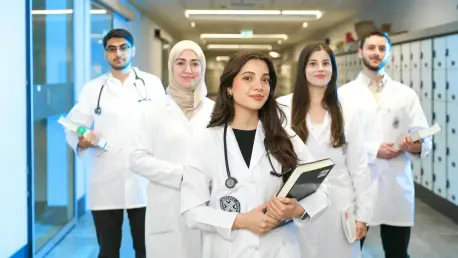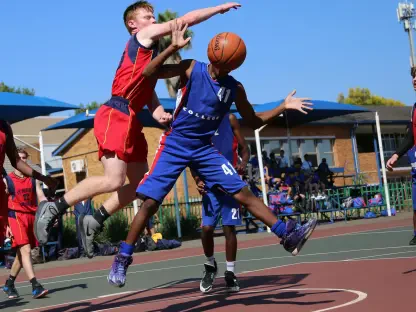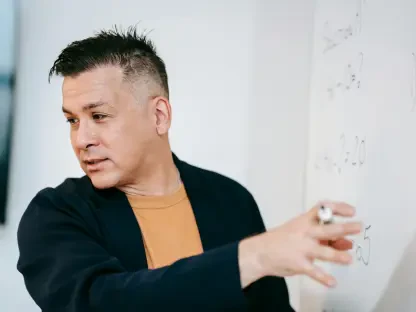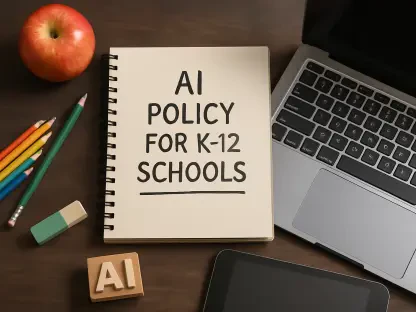In an era where global health challenges demand innovative solutions, international learning programs are emerging as a powerful force in medical education, uniting students and professionals across borders to tackle pressing issues. The collaboration between Carle Illinois College of Medicine (CI MED) in the United States and National Yang Ming Chiao Tung University (NYCU) in Taiwan stands as a prime example of how such initiatives can transform the landscape of healthcare training. By facilitating student exchanges and immersive experiences, these programs not only advance technical skills but also cultivate a profound understanding of diverse cultural perspectives. The result is a new generation of physicians, scientists, and engineers equipped to address complex problems with creativity and empathy. This growing trend of cross-border partnerships, supported by initiatives like the Global Consortium for Innovation and Engineering in Medicine (GCIEM), signals a shift toward a more interconnected approach to medicine, where shared knowledge and resources drive progress on a worldwide scale.
Key Partnerships Driving Medical Innovation
Building Bridges through Exchange Programs
The student exchange program between CI MED and NYCU exemplifies the potential of international collaboration to reshape medical education by fostering unique learning opportunities. Each year, a select group of students from both institutions immerses themselves in the academic and cultural environments of the other’s campus, engaging in research projects and internships that broaden their expertise. For CI MED students, this means delving into health research at NYCU’s Taipei campus, while NYCU students gain hands-on experience at CI MED’s JUMP Simulation Center in Illinois. This mutual learning fosters a dynamic exchange of ideas, blending distinct approaches to problem-solving. Under the umbrella of GCIEM, the partnership prioritizes interdisciplinary solutions, ensuring that participants address global health challenges with a comprehensive perspective. Such initiatives highlight how structured exchanges can create lasting connections, paving the way for innovations that transcend geographical boundaries and enhance medical training on a global level.
Beyond the immediate academic benefits, these exchanges nurture a sense of camaraderie and shared purpose among participants. The immersive nature of the program allows students to step outside their familiar settings, confronting real-world healthcare disparities and cultural nuances firsthand. This exposure often proves transformative, as students return with a deeper appreciation for the complexities of global health systems. Leadership from both institutions emphasizes that these experiences are not just about skill-building but also about forging a mindset of collaboration. By working alongside peers from different backgrounds, students develop the ability to navigate diverse teams, a critical competency in today’s interconnected medical field. The emphasis on mutual growth ensures that both CI MED and NYCU contribute unique strengths, creating a synergy that amplifies their collective impact on healthcare innovation.
Strengthening Global Networks
The broader framework of GCIEM serves as a catalyst for uniting academic institutions in the pursuit of medical advancement, encouraging a collaborative ethos where shared goals take precedence over individual achievements. This consortium fosters partnerships that extend beyond a single exchange program. The alliance between CI MED and NYCU is a cornerstone of this vision, demonstrating how structured cooperation can lead to tangible outcomes in health research and training. By aligning their efforts, the institutions leverage complementary resources, such as advanced facilities and specialized expertise, to tackle pressing issues like disease prevention and treatment accessibility. The commitment to interdisciplinary approaches ensures that engineering, technology, and medicine converge in meaningful ways, setting a precedent for other universities to follow. This model of global networking underscores the importance of sustained partnerships in building a resilient healthcare ecosystem.
Moreover, the ripple effects of such networks are felt far beyond the participating institutions. As students and faculty share their findings and experiences, they inspire similar initiatives in other regions, creating a domino effect of collaboration. The exchange program’s success serves as a blueprint for how academic alliances can address universal challenges, from pandemics to chronic illnesses, by pooling intellectual capital. Testimonials from participants often highlight how these connections open doors to international research opportunities and cross-border projects that would otherwise remain out of reach. The emphasis on shared learning also cultivates a culture of innovation, where novel ideas are tested and refined through diverse perspectives. Ultimately, these global networks reinforce the notion that the future of medicine hinges on collective effort, with partnerships like CI MED and NYCU leading the charge.
Technology as a Catalyst for Training
Advancing Skills with Immersive Simulations
At the forefront of medical education innovation lies the integration of cutting-edge technology, particularly through extended reality (XR) and virtual reality (VR) simulations at facilities like the JUMP Simulation Center. NYCU students, alongside University of Illinois interns, are actively involved in developing digital assets that replicate patient symptoms with striking realism. These tools surpass traditional training methods, such as high-fidelity manikins, by offering lifelike scenarios that test critical skills like diagnosing respiratory conditions or performing complex procedures like lumbar punctures. The use of AI-driven dialogue within these simulations adds another layer of sophistication, enabling students to engage with virtual patients in a conversational manner. This technological leap forward ensures that trainees are better prepared for the unpredictability of real-world medical situations, enhancing both accuracy and confidence in their decision-making processes.
The mentorship provided by XR specialists at the JUMP Simulation Center plays a pivotal role in refining these innovative tools, ensuring that they meet the highest standards of quality. By guiding students through the intricacies of virtual design, experts ensure that the simulations are not only technologically advanced but also pedagogically sound. This collaborative environment allows for continuous feedback, where NYCU participants bring fresh perspectives from their backgrounds in computer science and engineering, complementing the medical expertise of their CI MED counterparts. The resulting VR assets are tailored to address specific educational gaps, making training more targeted and effective. Beyond technical skills, these simulations foster critical thinking, as students must navigate complex scenarios that mirror the challenges of clinical practice. This fusion of technology and education exemplifies how international partnerships can push the boundaries of what’s possible, creating a new standard for medical training that prioritizes immersion and innovation.
Harnessing AI for Educational Excellence
Artificial intelligence (AI) is rapidly becoming a cornerstone of medical education, particularly within the collaborative projects at the JUMP Simulation Center. By embedding AI-based dialogue into VR simulations, developers create virtual patients capable of responding dynamically to student interactions, mimicking real-life consultations with uncanny accuracy. This advancement allows trainees to practice nuanced communication skills alongside clinical diagnostics, preparing them for the interpersonal demands of healthcare. The technology also enables personalized learning experiences, as AI can adapt scenarios based on a student’s progress or areas of weakness. Such tailored approaches ensure that educational outcomes are maximized, addressing individual needs within a standardized framework. The integration of AI underscores the forward-thinking nature of these international programs, positioning participants at the cutting edge of medical pedagogy.
Furthermore, the use of AI in simulations extends beyond immediate training benefits to long-term research potential. Data collected from student interactions with virtual patients can be analyzed to identify common errors or gaps in knowledge, informing curriculum adjustments and teaching strategies. This data-driven approach enhances the overall quality of medical education, ensuring that programs remain responsive to evolving needs. Collaborations between CI MED and NYCU amplify these efforts, as diverse teams bring varied insights into AI development, from algorithmic design to clinical relevance. The result is a robust set of tools that not only train current students but also lay the groundwork for future innovations in healthcare education. By harnessing AI, these partnerships demonstrate a commitment to leveraging technology for both practical and visionary purposes, shaping a more adaptable and skilled medical workforce.
Cultural Exchange and Professional Growth
Embracing Diversity in Medical Perspectives
Cultural immersion stands as a defining feature of the CI MED-NYCU exchange, profoundly shaping participants’ professional outlooks and providing a unique opportunity for growth. CI MED students, under the mentorship of Senior Associate Dean Janet Jokela, engage in biomedical research alongside NYCU experts at the Taipei campus, gaining exposure to unique methodologies and healthcare challenges. This cross-cultural collaboration goes beyond academic learning, fostering a deeper appreciation for how societal and environmental factors influence medical practice. Students often return with broadened perspectives, recognizing the importance of tailoring care to diverse populations. Leadership from both institutions notes that such experiences cultivate empathy, a vital trait for healthcare providers navigating globalized systems. By embedding cultural exchange into medical training, the program ensures that future professionals are not only skilled but also sensitive to the human dimensions of their work.
The impact of these immersive experiences often manifests in subtle yet significant ways, reshaping how students approach their careers. Working in an unfamiliar cultural context challenges preconceived notions, encouraging adaptability and open-mindedness—qualities essential for addressing complex health issues. For instance, CI MED participants frequently cite how collaborating with Taiwanese researchers revealed alternative approaches to patient care and resource allocation, insights that enrich their own practices. This reciprocal learning environment also builds lasting professional networks, as students forge connections that facilitate future cross-border projects. The emphasis on cultural understanding aligns with the broader mission of international education: to create a medical community that values diversity as a strength. Through these exchanges, the groundwork is laid for a more inclusive approach to healthcare, where differences in perspective fuel innovation rather than division.
Shaping Career Trajectories through Global Exposure
Participation in international programs often marks a turning point in students’ professional journeys, redefining their ambitions and skill sets. Many describe these exchanges as career-defining, noting how exposure to new environments and challenges clarified their long-term goals. For CI MED students, conducting research in Taiwan under NYCU’s guidance provided not just technical expertise but also a glimpse into the global scope of medical challenges, inspiring pursuits in fields like global health policy or international research. Similarly, NYCU students at the JUMP Simulation Center gained unique insights into integrating technology with medicine, sparking interest in innovative specialties. These transformative moments underscore the value of stepping outside familiar boundaries, as they equip participants with a versatile mindset ready to tackle multifaceted issues in healthcare.
Additionally, the personal growth stemming from these experiences often translates into professional resilience, a critical asset in the demanding field of medicine. Navigating cultural differences and academic rigor abroad hones problem-solving abilities and emotional intelligence, preparing students for the complexities of patient care in diverse settings. Accounts from participants frequently highlight how overcoming language barriers or adapting to new workflows strengthened their confidence and adaptability. This holistic development is a deliberate outcome of the exchange program, designed to produce well-rounded professionals who can thrive in varied contexts. The lasting impact of such global exposure is evident in the way alumni continue to advocate for international collaboration, often initiating similar programs in their own institutions. By prioritizing both personal and professional evolution, these initiatives ensure that the benefits of cultural exchange endure long after the program concludes.
Individual Impact and Research Breakthroughs
Pioneering Solutions for Rare Disorders
The tangible outcomes of international collaboration shine through in the groundbreaking research conducted by students like Tony Tu from CI MED, who focused on developing a deep-learning algorithm to detect reversible cerebral vasoconstriction syndrome (RCVS). This rare disorder can lead to severe complications if undiagnosed, making early detection critical. Access to an extensive database of magnetic resonance angiography (MRA) scans in Taiwan proved instrumental in training the algorithm, while Taiwanese clinicians offered specialized expertise in MRA analysis. Complementing this, U.S.-based Dr. Daniel Llano provided critical insights into RCVS diagnostics, creating a powerful synergy. Tu’s reflections emphasize how this cross-border partnership accelerated discovery by combining diverse strengths, ensuring findings that are more generalizable across populations. Such projects highlight the unparalleled value of global teamwork in addressing niche medical challenges.
The significance of Tu’s work extends beyond immediate results, offering a model for how international research can bridge critical gaps in knowledge and advance medical science. By leveraging resources and expertise from multiple regions, the project not only advanced understanding of RCVS but also demonstrated the efficiency of collaborative approaches in rare disease research. This effort underscores a broader trend: complex health issues often require a mosaic of perspectives to yield effective solutions. The rapid accumulation of cases and data through NYCU’s infrastructure, paired with diagnostic acumen from the U.S., exemplifies how shared efforts can compress timelines for innovation. Furthermore, the success of this research serves as an inspiration for other students, illustrating that international partnerships can tackle even the most elusive medical problems. The impact of such work reverberates through the academic community, encouraging more institutions to prioritize collaborative research frameworks.
Transforming Training through Virtual Innovation
Equally impressive are the contributions of NYCU students at the JUMP Simulation Center, where their development of virtual reality assets is redefining medical training. Working alongside University of Illinois graduate students and under the guidance of XR experts, the team created simulated patients with lifelike symptoms, enhancing the realism of educational scenarios. These assets, designed for integration into VR platforms, target essential skills like diagnosing conditions and performing intricate procedures. The use of state-of-the-art tools ensures that the simulations are not only visually accurate but also functionally robust, providing a safe space for trainees to hone their abilities. This innovation reflects a growing recognition of immersive technology’s potential to transform how future healthcare professionals prepare for clinical challenges, setting a new benchmark for educational tools.
The broader implications of these virtual innovations signal a shift toward technology-driven learning in medicine, highlighting a transformative approach for future healthcare professionals. By creating assets that mirror real patient interactions, NYCU students contribute to a training paradigm that prioritizes experiential learning over traditional methods. The collaborative nature of the project, blending engineering prowess with medical insight, ensures that the resulting tools are both cutting-edge and relevant to clinical needs. Feedback from mentors at the center further refines these simulations, aligning them with educational objectives while pushing technological boundaries. This effort not only benefits current trainees but also paves the way for scalable solutions that other institutions can adopt. As immersive technologies continue to evolve, the work done through this partnership stands as a testament to how international collaboration can drive progress, equipping the medical field with resources that enhance both learning and patient outcomes.
Expanding Global Engagement
Fostering Compassion through Service Missions
The Discovery Learning course at CI MED extends the reach of international learning by challenging second-year medical students to engage in diverse global experiences, from clinical research to service missions. One such example is Conway Hsieh’s participation in a medical mission with VnHOPE in rural Vietnam, where free dental, optometric, and other healthcare services were provided to underserved communities. This hands-on exposure to primary care, pediatrics, and pain management in resource-scarce settings profoundly shaped Hsieh’s commitment to patient-centered care. The experience highlighted the stark realities of healthcare disparities, reinforcing the importance of accessibility and empathy in medical practice. Such missions, integral to the course, emphasize the role of global engagement in building professionals who prioritize service alongside technical expertise, ensuring that compassion remains at the heart of their work.
Beyond personal transformation, these service missions contribute to a broader understanding of global health challenges within the medical community. Participants like Hsieh often share insights from their experiences, sparking discussions on how to address systemic issues such as limited access to care in remote areas. The Discovery Learning course’s design encourages students to reflect on their roles as advocates for change, pushing them to consider innovative solutions for underserved populations. By embedding service into medical education, the program ensures that future physicians are not only skilled clinicians but also socially conscious leaders. The impact of these missions resonates through the stories of improved patient outcomes and strengthened community ties, illustrating the profound difference that even short-term interventions can make. This focus on service underscores the course’s mission to create a ripple effect of positive change through global exposure.
Embracing Diverse Healthcare Environments
The scope of the Discovery Learning course is further evidenced by the variety of international settings in which students participate, spanning from Vietnam to Guatemala, offering a broad spectrum of cultural and clinical experiences. Eight out of 55 students in a recent cohort opted for overseas experiences, immersing themselves in clinical and cultural contexts vastly different from their own. These opportunities expose participants to unique healthcare systems, often characterized by limited resources and distinct patient needs, fostering adaptability and resilience. For instance, working in Guatemala offered students a firsthand look at tropical disease management and community-based care, skills rarely encountered in standard curricula. This diversity of experience ensures that medical training is not confined to a single perspective but enriched by a tapestry of global insights, preparing students for the multifaceted nature of modern healthcare delivery.
The value of engaging with varied environments lies in the nuanced understanding it imparts, equipping students to address health issues through a culturally informed lens, and encounters with different medical practices and societal attitudes toward health challenge participants to rethink conventional approaches. These encounters often lead to more holistic strategies in their future work. Leadership at CI MED notes that such exposure is critical for developing professionals who can operate effectively in international or underserved settings. The stories emerging from these experiences often highlight personal growth alongside professional development, as students navigate language barriers and resource constraints with ingenuity. By prioritizing global engagement, the Discovery Learning course reinforces the importance of versatility in medicine, ensuring that graduates are prepared to serve diverse populations with both competence and cultural sensitivity.
Reflecting on a Collaborative Legacy
Looking back, the strides made through international learning initiatives between institutions like CI MED and NYCU marked a pivotal moment in medical education. These partnerships demonstrated how shared expertise and cultural exchange could yield groundbreaking advancements, from deep-learning algorithms for rare disorders to virtual reality tools that redefined training. Programs like the Discovery Learning course further expanded this impact, embedding a global perspective into the fabric of healthcare training through service and clinical missions. The commitment to collaboration cultivated a generation of professionals who valued empathy as much as innovation. Moving forward, the focus should shift to scaling these models, encouraging more institutions to adopt similar exchanges and immersive experiences. Investing in technology and fostering sustained global networks will ensure that the legacy of these efforts continues to address evolving health challenges, building a more connected and capable medical community for the future.









